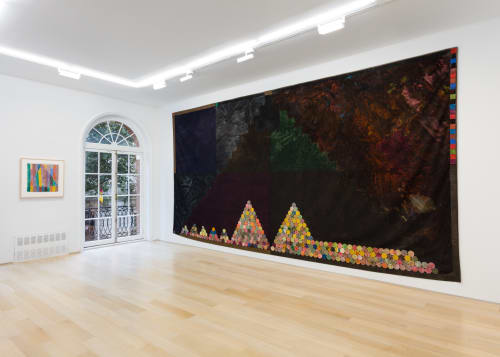Alan Shields: Space Sisters: Work from the 1970s
-
Overview
Van Doren Waxter is pleased to announce Space Sisters, an exhibition of paintings and works on paper by Alan Shields, on view from September 14 through October 28, 2016. The exhibition will focus on a selection of pieces from the 70s, presenting examples of Shields’ most bombastic work along with his quietest, highlighting a period in Shields’ career when he was receiving international recognition.
Emblematic of the freewheeling ethos of the period, Shields’ semiotic style includes spirals, mazes, pyramids, mandalas, anthropomorphic and natural forms. Shields’ command of color and form epitomize the American Post-Minimalist movement, seen in the large-scale, highly adorned multi-media painting, Space Sisters, 1972-74, an ecstatic example of the artist’s exploration of materiality, which employs acrylic, cotton thread, beads and mop heads on linen.
By contrast, the less ebullient large-scale painting, Jello Apples, shows the artist’s restraint. Dominated by what appears to be black ground, but what is actually several mottled colors blooming through a dark field, the painting is punctuated with geometric stitching and a horizon of painted and dyed fabric circles sewn on to create curvilinear forms. This subtlety is echoed in the simplistic beauty of the “Brown Box Set” series (1974-75), which, along with his drawings on paper towels, are Shields at his most pared down—no ornamentation, only watercolor, paint and pencil. Immediate and personal in scale, these smaller works can be seen as ethereal impressions—keys to the artist’s larger works and his career-long exploration of unconventional materials and varied forms.
Born in Kansas and raised on his family’s farm, Alan Shields approached a growing interest in Post-Minimalism—a movement co-opted by installation and land artists like Richard Serra and Robert Smithson—with a synthesis of material assemblages that fused the lingering hippiedom of the 60s, folk motifs, and non-Western imagery with the techniques of Color Field painting and the fluid gesture of Abstract Expressionism into a thoroughly unique and singular aesthetic.
Governed primarily by his interests, Shields engaged in a diverse practice, leaving behind a body of work that includes sculptures, paintings, prints, works on paper and wearable work, among other experiments with handmade paper, string, cotton pulp, steel and stop-motion animation. Insofar as he adopted a signature style, it might be his complete rejection of stretched canvas in favor of a less precious, more accessible art.
Shields’ legacy continues to reverberate amongst significant contemporary artists in conversation with his approach to craft and the unframed object: Jim Lambie’s sculptural assemblages; Polly Apfelbaum’s chromatic “carpets;” Jessica Stockholder’s interactive installations which co-opt the floors and walls—the list of those who sample Shields’ interest in remaining uncircumscribed by standards or popular movement is long, and stands to grow longer.
-
Installation Shots
-
Artist



